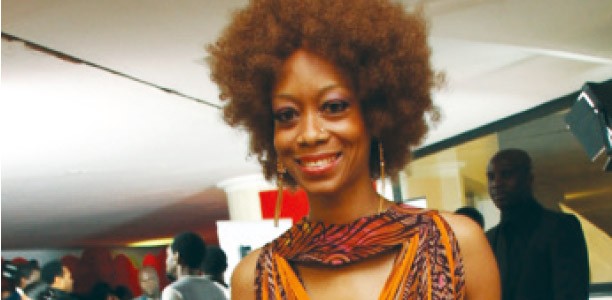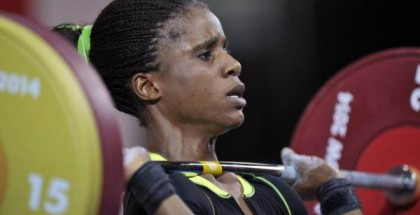Nigerian women are fabulous dressers –Kiki Kamanu
konknaijaboy | On 01, Jan 2014
Designer Kiki Kamanu is creativity defined. There is no dull moment with this busy bee of American and Nigerian parentage. Her almost frail build is a sharp contrast with her creativity which is evident in her designs.
Educated both in the United States and France, this former runway model-turned- designer is the face of her distinctive chic brand. With several years of experience designing her own clothes and her love to travel, Kiki draws inspiration from a myriad of sources. Her designs have been featured twice during the London Fashion Week, at Lagos Fashion and Design Week, the ARISE Magazine Fashion Week and in the Face of Sleek.
For the benefit of fashion lovers everywhere, Kiki left a career at Harvard Medical School where she was the Neurosurgery Education Programme Co-ordinator to devote her energy into producing well-tailored exclusive designs. Ordinary never does it for this young woman as her outfits always scream unique and fabulous to the rooftop. She told Sunday Sun she is always thrilled dressing women who are confident about their bodies no matter their sizes.
Excerpts:
How long have you been creatively putting smiles on people’s faces?
I have been doing this for over three years now and prior to that, it was just a hobby. I would design clothes for myself and for my sister as well. Later on, I started making clothes for beautiful people and they love it.
Would you say you were destined to make clothes?
I have always had a creative flair and streak. I had always painted and worn creative pieces on the runway as a model. I have always sketched my own pieces since I was 11. I have always styled people and being creative has been a part of me. Whenever I go shopping for shoes and clothes, I always get the more artistic , unique and different ones and not just something everyone is used to. I love pieces that stand out. So yes, being creative has always been a part of me.
How has the journey been so far?
It has been fantastic for me. I started out in New York. Stores where I retail my fashion pieces were closing down because of the harsh financial climate and I realized that there was a lot of opportunities in Nigeria as people were willing to spend money for my pieces. I met with the right people who put me through what it takes to excel in the Nigerian fashion industry. Since then, I’ve been dressing fashionable men and women. I have showcased my designs twice at the London Fashion Week. I have a client base in four continents and I would say it has been great for me. I am not complaining.
How would you describe your modeling days abroad?
It was fantastic. I have modeled for big names and small names in New York. I was sought after because of my work. It was different. Being a black model in the states makes you stand out,because there were not many of us then. I always got jobs.
Why did you change careers?
I changed careers because I have been a very creative person for as long as I can remember. After modeling, I had a nine to five job at Harvard, before I went into making clothes to make money. I am thankful for the knowledge I gained working in a corporate environment, it prepared me on how to handle my budgets and how to be a team leader. The design aspect is only 5 per cent of the equation and so much more has to be done outside the workshop. I met with some already established names in the industry that helped sharpen me for success.
My stint at Harvard as the Neurosurgery Education Programme Coordinator was great but it gets to a point in life when you can no longer do something , because it doesn’t reflect who you are anymore. One day, I realized how passionate I was about creatively making wearable clothes, so I quit my job at Harvard and pursued my passion. I was born to do this.
Is the fashion industry as glamorous as it looks on the runway?
It is only glamorous for 5 minutes. This is because we get to see only the finished product and not what really goes into making that piece beautiful. It is a lot of work, sweat and phone calls and stress to bring out that glamorous finish. That is why being a team leader is very important. You need to get your team to believe in you. You also have to instill your beliefs in them.
How do you keep it together amidst the screaming, stress and sweating?
I love what I do. My passion for making clothes makes it easier for me to deal with the unglamorous side of making clothes. I don’t have a plan b, so I stick to designing clothes. It is something I would do for free but because I have to pay my bills, I have to deal with the challenges and overcome them. I don’t like Fridays but I love Mondays because it keeps me on my toes.
What misconceptions do people have about the fashion industry?
People think it’s easy and it’s not a real job. They think it’s a hobby and designers and models are not serious people. What people fail to realize is that someone or some things did influence what models wear on the runway and it takes a lot of effort and team work to arrive at a finished creative piece. There are many steps involved in designing clothes and it costs people a lot of effort. Fashion is a very powerful industry and people going into it must make clear distinctions whether it would be a hobby or a career.
Have things improved in the fashion industry despite what people outside think?
This is the best time to be in the fashion industry in Africa and in Nigeria. We are bringing fashion to the world now. The Lagos Fashion Design Week is an avenue where foreigners gather in Nigeria to see what we have to offer and we have not disappointed them. So many of us have been able to showcase our designs in London, Paris and New York because the world wants what we have to offer.
What category of women wear your designs?
Anyone from the age of 4 to 90 would wear my clothes. The key is to make something for everyone. I sketch designs that would come out comfortable because I want my clients to be classy yet comfortable with my designs. From size 0 to size 18 because the everyday woman is not what you see on the runway. I make realistic clothes. What I love about Nigerian women’s body is their confidence with what they wear. They are big, they know it, they love it and they rock it. I make dress for that woman. I give women an extra boost of confidence they need.
How do you get inspirations for your designs?
I get them from everywhere. I could get inspired from the design of my door or from the colour of someone’s car. I am always with my note pad and coloured pencil to sketch anything that comes to me.
How long does it take you to create a particular piece?
It varies from the design to the material I use. Some designs take 20 to 30 minutes. Some take days to conceptualize, while others can take weeks to create. Some can take months.
What fabrics get it done for you?
I use African prints. The African fabric is cotton but I love to use African inspired materials like chiffon and jersey fabrics. They make designing exciting. But I do love prints a lot. I use bold colours and love to mix different pieces that are never dull or boring. I create pieces that stand out but also flow with every woman’s wardrobe.
What distinguishes your designs from those of other designers’?
The complexity and the simplicity of my designs stands me out. It may be complex to put together, yet it looks effortless when people wear it. I can combine styles and patterns that stand out. We take simple materials and create complex designs, which come out flawless. That is what stands me out.
How much of yourself goes into your designs bearing in mind that you’re also creating pieces for other people?
It took me a while to blend into making clothes for people other than me. From an early age, I had been making clothes for me and so I had to take into consideration also that my clients might not like my preferences. I had to start designing without putting anything about me into those designs. I started taking the sizes and preferences of my clients into serious consideration. It is good to know your market and listen to suggestions, criticisms and advice. I am constantly learning, perfecting my art.
When you decided to go into fashion designing full time, what kind of impact and impression did you wish to leave behind?
The main thing I wanted to do was to give back to the society. I have a goal to leave a lasting impact on the people I work with and those around them. I have a mentoring programme for people all over the world who want to be in the fashion industry but don’t know how to go about it. We take them, train them and educate them on how to run the business side of fashion. They are taught how to relate with clients and also how to pacify angry ones. They learn the marketing and selling aspects as well.
What can you say about your current collection?
The rich, vivid colours of Ethiopia inspire my current spring/summer collection as I drove for hours between villages, sourcing fabrics, photographing the different tribes people of the Omo valley. From the rainbow themed skirts of the Konso women to hundreds of vibrant hued beads layering the necks of the clay lip-plated Mursi women. My trip to Ethiopia was a wonderful experience. I was struck by how warm and trusting the Ethiopians were. They welcomed me in their midst and provided me with the Menen fabric which is inspired by the traditional hand woven and embroidered clothing which Abyssinians have worn since ancient times.
What trends do you see taking over the scene next year?
Prints and more prints will take over the scene. Prints will be on the scene for the next five seasons because of their versatility. Mustard will be the reigning colour and comfort remains key to fabulous designs.
What’s your background like?
My mum is American and my dad is Nigerian. My mother grew up in different countries because my American grand father was in the Army. My name Kiki was given to me from my mother’s side of the family.















